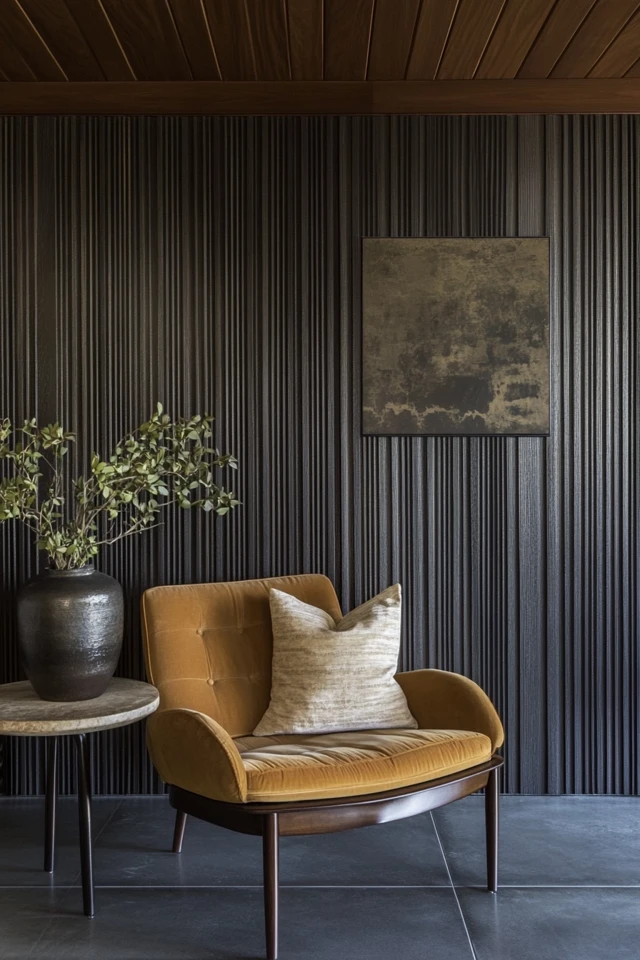Before Reading this Article, Hire Us As Your Designer or Take a Look at My Top 3 Amazon Picks!
If you are looking to blend Amazon's furniture finds with a personalized touch for your space, check out my portfolio, and hire us! You'll get 3 Idea boards, 2 Concept Boards, 2 Realistic Renderings, a Floor Plan, and a Shopping List! Everything's online, plus a 25% discount on your first online interior design project with my Havenly Promo code 4c7441bcfb. With over 2,000 designs since 2017 and top US brand partnerships, your project is in expert hands. US only. Ready to start?
AEPOALUA Nightstand with Drawers, Fluted Night Sta...
$69.99 (as of January 21, 2025 21:08 GMT -06:00 - More infoProduct prices and availability are accurate as of the date/time indicated and are subject to change. Any price and availability information displayed on [relevant Amazon Site(s), as applicable] at the time of purchase will apply to the purchase of this product.)Liotww Ceramic Vases for Home Decor Set of 2, Off ...
$32.99 (as of January 21, 2025 21:08 GMT -06:00 - More infoProduct prices and availability are accurate as of the date/time indicated and are subject to change. Any price and availability information displayed on [relevant Amazon Site(s), as applicable] at the time of purchase will apply to the purchase of this product.)Christopher Knight Home Fernhill Upholstered Pushb...
$248.88 (as of January 21, 2025 21:08 GMT -06:00 - More infoProduct prices and availability are accurate as of the date/time indicated and are subject to change. Any price and availability information displayed on [relevant Amazon Site(s), as applicable] at the time of purchase will apply to the purchase of this product.)Mid-century modern design is all about clean lines, functional beauty, and simplicity, but one often overlooked element in this timeless style is the use of vertical lines. These lines can add height, structure, and sophistication to a space, while staying true to the understated elegance of mid-century modern design.
I first discovered the power of vertical lines when redesigning a small, boxy living room. By incorporating vertical paneling and a floor-to-ceiling shelving unit, the space felt taller and more open without adding any actual square footage. Ever since, vertical lines have become one of my go-to tools for creating balance and drama in mid-century-inspired interiors.
In this guide, I’ll walk you through creative ways to use vertical lines in mid-century modern design, from wall treatments to furniture and decor.
Why Vertical Lines?
Vertical lines are a subtle yet powerful design element that can transform a space by:
- Adding Height: They create the illusion of taller ceilings, making any room feel more spacious.
- Drawing the Eye Upward: This effect emphasizes architectural features and makes the design feel dynamic.
- Enhancing Simplicity: Vertical lines align with the minimalist ethos of mid-century modern design, adding texture without overwhelming the space.
1. Vertical Paneling for a Timeless Look
Why It Works:
Vertical wood paneling is a staple of mid-century modern design, offering warmth, texture, and visual interest while maintaining clean, linear aesthetics.
How to Incorporate It:
- Use floor-to-ceiling paneling on an accent wall to create a focal point.
- Choose natural wood tones like walnut, teak, or oak for an authentic mid-century feel.
- Paint vertical paneling in neutral shades like white, gray, or sage green for a modern twist.
Pro Tip: Keep the panel spacing consistent for a clean, uniform look.
2. Vertical Slats for Texture and Separation
Why It Works:
Vertical slats can define spaces in an open floor plan without fully enclosing them, maintaining the airy feel of mid-century modern design.
How to Incorporate It:
- Install a slatted wood divider between the living and dining areas.
- Use vertical slats as a decorative overlay on walls or windows for added texture.
- Choose slats in dark wood finishes for a dramatic contrast, or lighter woods for a softer, Scandinavian-inspired vibe.
Pro Tip: Play with spacing to create a mix of openness and privacy.
3. Floor-to-Ceiling Shelving Units
Why It Works:
Tall shelving units draw the eye upward and provide a functional, stylish way to showcase books, plants, and decor.
How to Incorporate It:
- Choose modular shelving with vertical dividers to emphasize the height of the space.
- Use open shelving to maintain a light, minimalist look.
- Pair with mid-century-inspired decor, such as geometric vases or vintage ceramics.
Pro Tip: Mix vertical shelving with horizontal surfaces like low-profile credenzas to balance the design.
4. Striped Wallpaper for a Retro Touch
Why It Works:
Vertical striped wallpaper adds instant mid-century flair while elongating walls.
How to Incorporate It:
- Choose patterns with subtle, earthy tones like mustard, olive, or rust for an authentic 1950s-60s look.
- Use striped wallpaper in small spaces like entryways or powder rooms for a bold statement.
- Opt for thinner stripes for a refined feel or bolder stripes for a more playful, retro vibe.
Pro Tip: Pair striped walls with solid-colored furniture to avoid visual clutter.
5. Vertical Tile Patterns in Kitchens and Bathrooms
Why It Works:
Installing tiles in a vertical layout is a modern interpretation of mid-century design that feels fresh and contemporary.
How to Incorporate It:
- Use vertically stacked subway tiles for a clean, minimalist look.
- Opt for vertically installed terrazzo tiles for a retro-inspired touch.
- Create a vertical backsplash in kitchens or bathrooms to draw the eye upward.
Pro Tip: Choose grout colors that contrast slightly with the tiles to emphasize the vertical lines.
6. Upholstered Furniture With Vertical Patterns
Why It Works:
Furniture with vertical tufting or stripes adds texture and elegance while maintaining the sleek lines of mid-century modern design.
How to Incorporate It:
- Choose sofas or armchairs with channel tufting for a subtle nod to vertical lines.
- Opt for dining chairs with vertically striped upholstery to complement a minimalist table.
- Use a headboard with vertical tufting in the bedroom for a touch of retro luxury.
Pro Tip: Stick to fabrics like velvet, leather, or linen in mid-century tones like mustard, teal, or gray.
7. Tall Drapes and Window Treatments
Why It Works:
Floor-to-ceiling drapes emphasize verticality, making windows appear taller and the room more expansive.
How to Incorporate It:
- Use solid-colored drapes in natural fabrics for a simple, modern look.
- Choose striped or patterned drapes for a more playful, mid-century vibe.
- Install curtain rods higher than the window frame to maximize the effect.
Pro Tip: Pair tall drapes with low-profile furniture to enhance the sense of height.
8. Lighting Fixtures With Vertical Lines
Why It Works:
Mid-century lighting often features vertical elements, like tall lamp bases or pendants with elongated shapes.
How to Incorporate It:
- Choose floor lamps with slim, vertical profiles, like the iconic Arco lamp.
- Use pendant lights with elongated shapes, such as cylindrical or cone designs.
- Incorporate wall sconces with vertical shades for accent lighting.
Pro Tip: Stick to finishes like brass, black, or matte white for an authentic mid-century look.
9. Art and Decor With Vertical Motifs
Why It Works:
Vertical patterns in art and decor subtly reinforce the theme without overpowering the space.
How to Incorporate It:
- Hang mid-century inspired prints featuring vertical lines or geometric patterns.
- Use tall vases or sculptures to add height to tabletops and shelves.
- Choose decor items like candle holders or lamps with vertical ridges.
Pro Tip: Group decor pieces in varying heights to create visual interest.
10. Vertical Flooring Patterns
Why It Works:
Installing flooring in a vertical direction can elongate the room and emphasize clean lines.
How to Incorporate It:
- Lay hardwood or laminate planks parallel to the longest wall to create a sense of flow.
- Use vertical herringbone patterns for a subtle twist on traditional flooring.
- Choose natural wood tones to complement mid-century furniture.
Pro Tip: Add an area rug with vertical or linear patterns to enhance the effect.
Picture Gallery
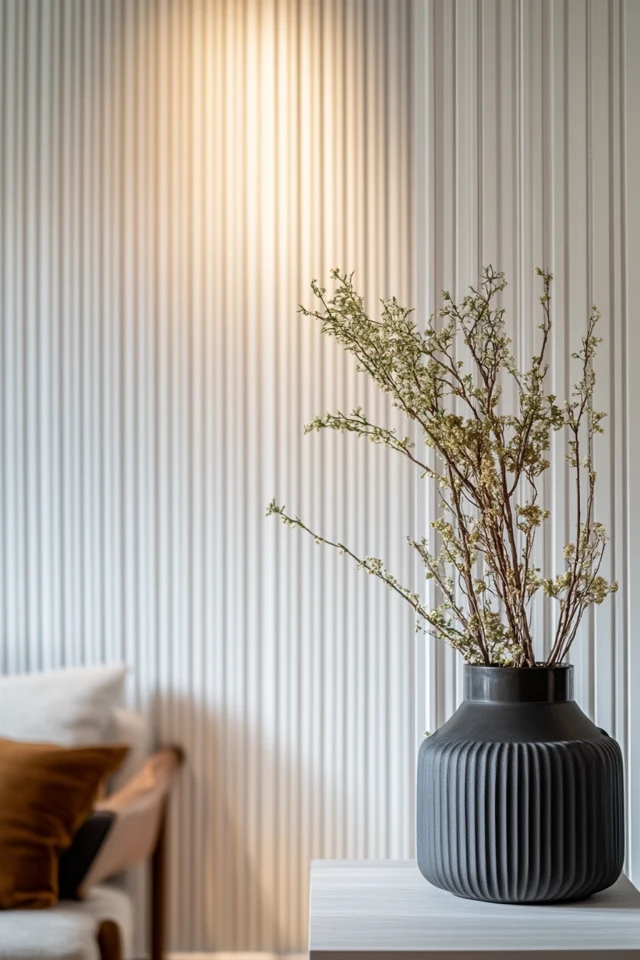
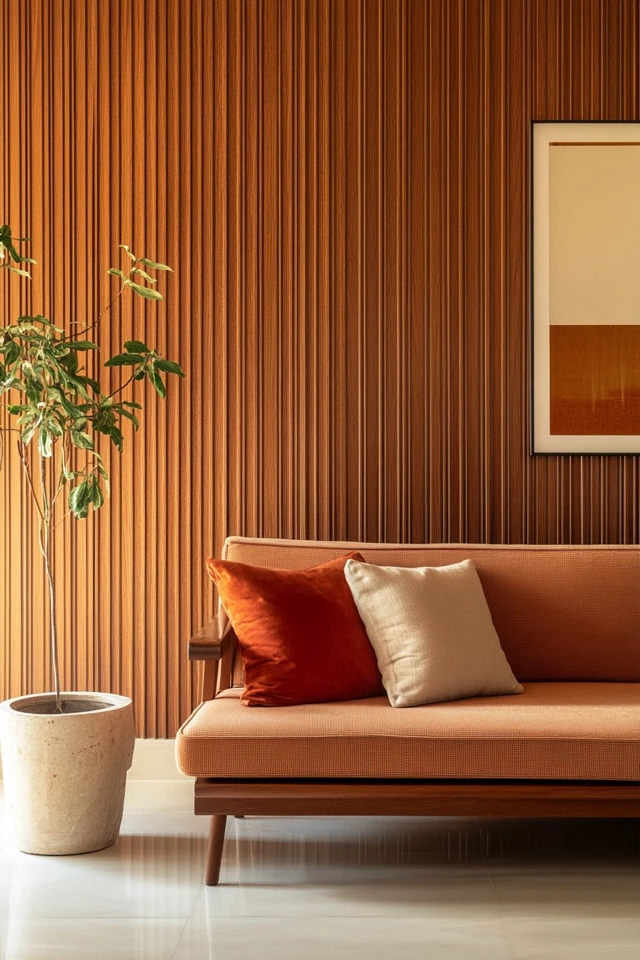
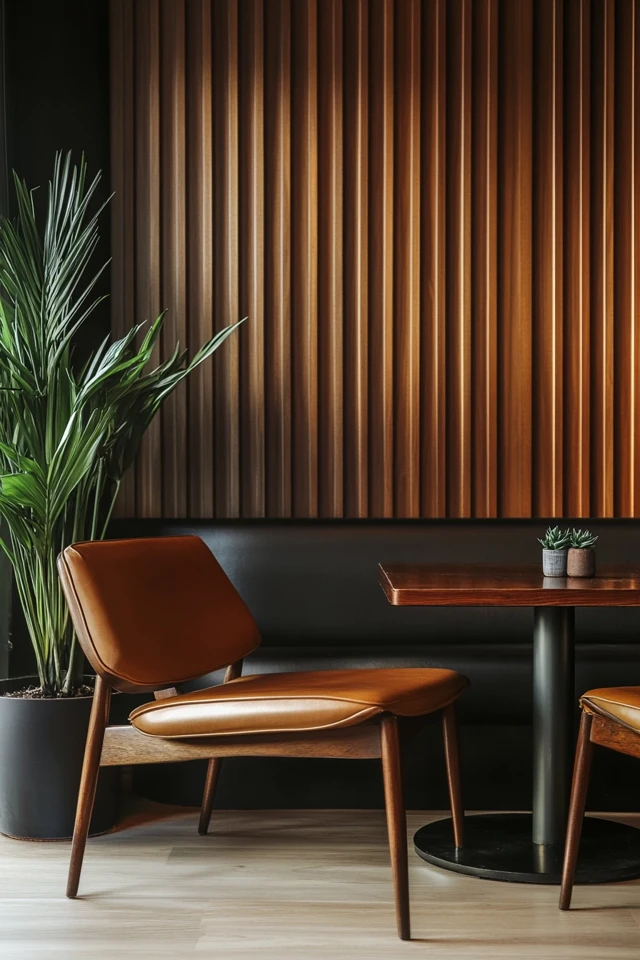
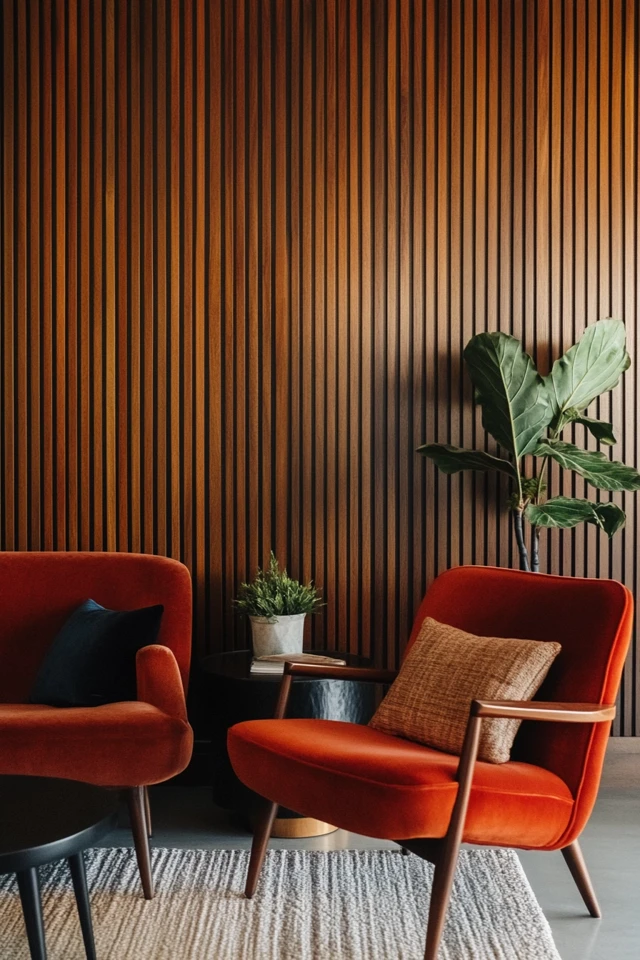
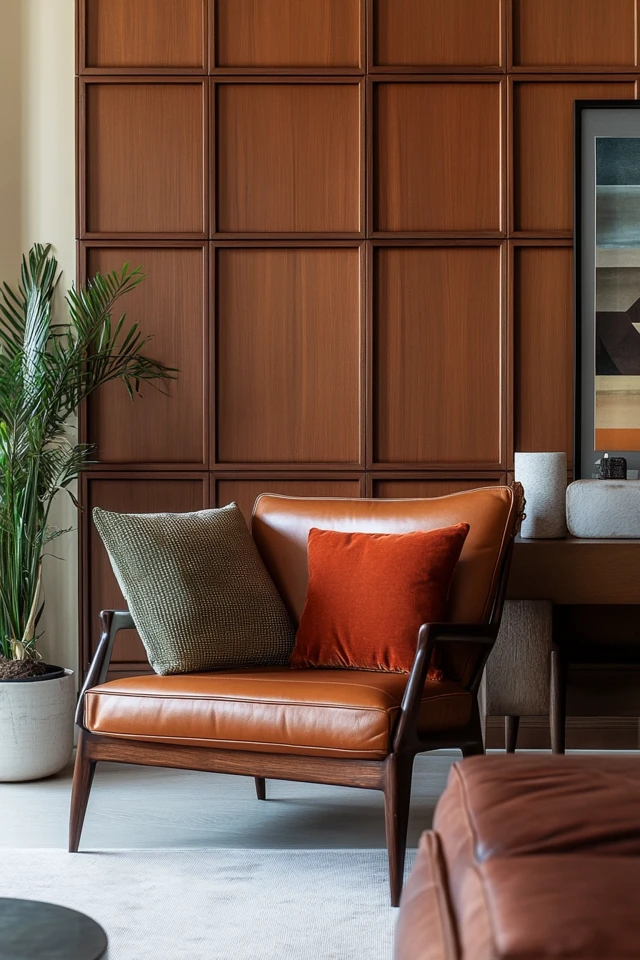
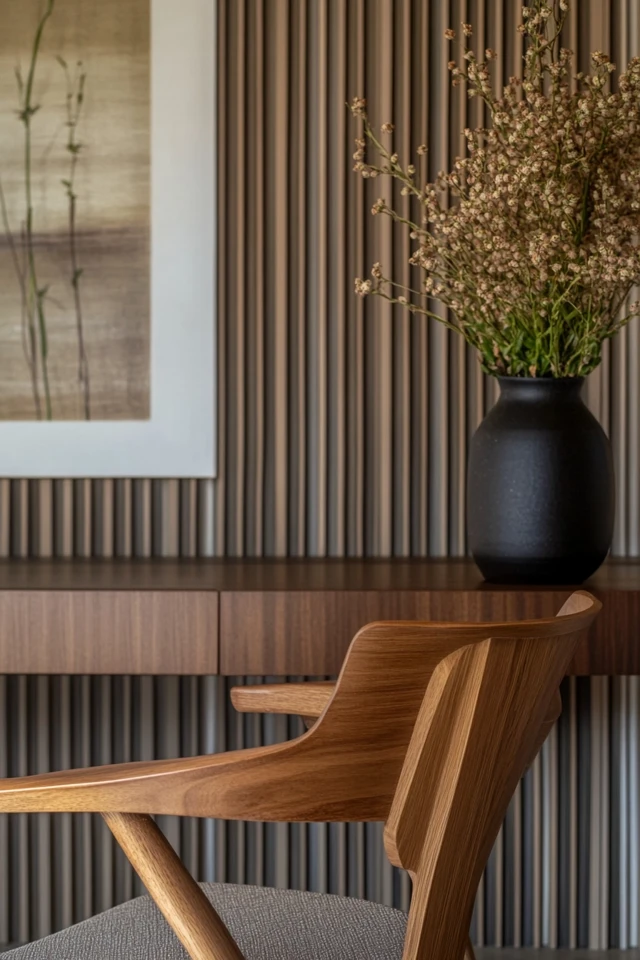
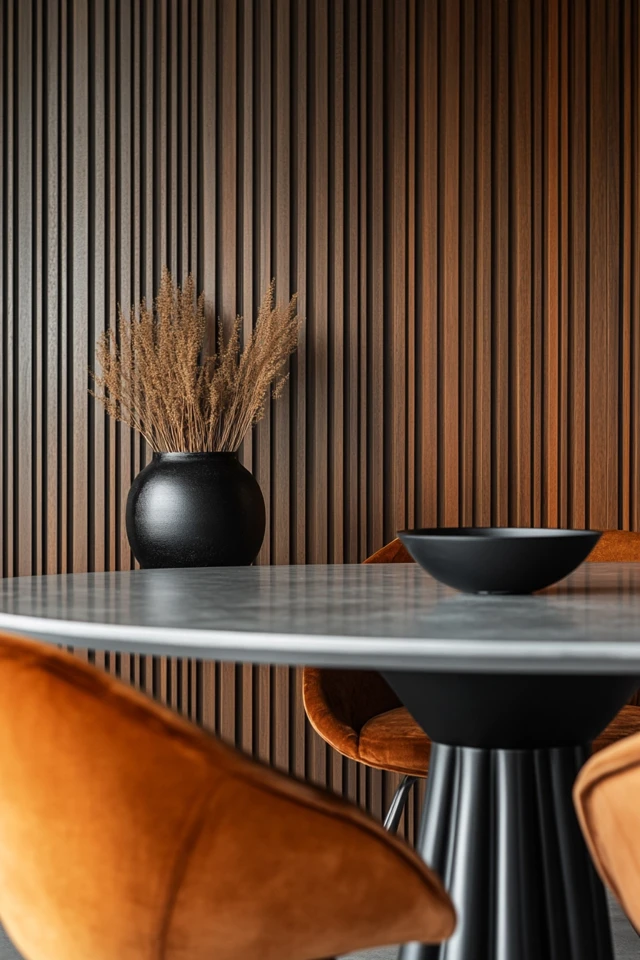

Conclusion
Vertical lines are a powerful design element in mid-century modern interiors, offering height, texture, and balance to any space. Whether through wall paneling, furniture, lighting, or decor, these lines can transform a room while staying true to the clean, minimalist ethos of mid-century design.
By incorporating vertical lines thoughtfully, you’ll create a space that feels taller, more dynamic, and effortlessly stylish. Whether you’re working with a small apartment or a spacious home, these tips will help you bring out the best in your mid-century modern aesthetic.
FAQs
1. Why are vertical lines important in mid-century modern design?
Vertical lines add height, structure, and a sense of movement to a space, aligning with the clean and dynamic principles of mid-century modern design.
2. Can I mix vertical and horizontal lines in one space?
Yes! Mixing vertical and horizontal lines creates contrast and balance. For example, pair vertical paneling with a horizontal credenza.
3. What materials work best for vertical elements?
Natural woods, metal accents, and textured fabrics are ideal for mid-century modern vertical designs.
4. How can I use vertical lines in small spaces?
Use vertical paneling, tall shelving, or striped wallpaper to draw the eye upward and make the space feel larger.
5. Where can I find mid-century modern decor with vertical motifs?
Check retailers like West Elm, Article, CB2, and Etsy for furniture, decor, and artwork with vertical patterns and mid-century charm.

